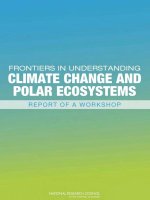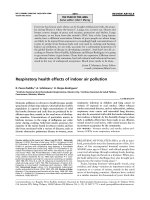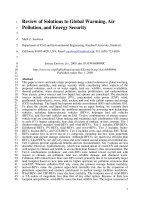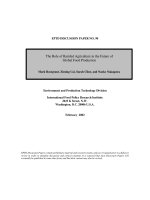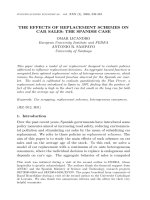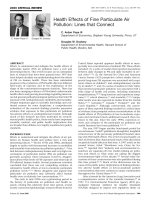Changing Ecosystems Effects of Global Warming doc
Bạn đang xem bản rút gọn của tài liệu. Xem và tải ngay bản đầy đủ của tài liệu tại đây (15.06 MB, 273 trang )
Changing
Ecosystems
Gl bal
WarminG
Gl bal
Warmin
Gl bal
Warmin
Julie Kerr Casper, Ph.D.
Changing
Ecosystems
Eects of Global Warming
Gl bal
WarminG
Gl bal
Warmin
Gl bal
Warmin
CHANGING ECOSYSTEMS: Eects of Global Warming
Copyright © 2010 by Julie Kerr Casper, Ph.D.
All rights reserved. No part of this book may be reproduced or utilized in any form or by any means,
electronic or mechanical, including photocopying, recording, or by any information storage or
retrieval systems, without permission in writing from the publisher. For information contact:
Facts On File, Inc.
An imprint of Infobase Publishing
132 West 31st Street
New York NY 10001
Library of Congress Cataloging-in-Publication Data
Casper, Julie Kerr.
C
ha
nging ecosystems : eects of global warming / Julie Kerr Casper.
p. cm.—(Global warming)
Includes bibliographical references and index.
ISBN 978-0-8160-7263-7 (hardcover)
ISBN 978-1-4381-2739-2 (e-book)
1. Ecology—Popular works. 2. Biotic communities—Popular works. 3. Global warming—Popular
works. I. Title.
QH541.13.C37 2009
577.27'6—dc22 2009001411
Fac
ts On File books are available at special discounts when purchased in bulk quantities for
businesses, associations, institutions, or sales promotions. Please call our Special Sales Department
in New York at (212) 967-8800 or (800) 322-8755.
You can nd Facts On File on the World Wide Web at tsonle.com
Text design by Erik Lindstrom
Illustrations by Sholto Ainslie, Richard Garratt, Accurate Art, and Lucidity Information Design
Photo research by the author
Composition by Hermitage Publishing Services
Cover printed by Bang Printing, Brainerd, MN
Book printed and bound by Bang Printing, Brainerd, MN
Date Printed: November 17, 2009
Printed in the United States of America
10 9 8 7 6 5 4 3 2 1
is book is printed on acid-free paper.
Contents
Preface viii
Acknowledgments xii
Introduction xiv
1 Signs and Eects of Global Warming 1
e Eects of Global Warming on Ecosystems 2
Scientic Findings 7
Observed and Expected Eects on Ecosystems 10
Why a Few Degrees Matter 14
Results of Global Warming on Ecosystems 15
2 Ecosystems, Adaptation, and Extinction 21
Biodiversity and Ecosystems 21
e Eects of Climate Change on Ecosystems 35
Impacts, Vulnerability, and Adaptation 41
Preservation Issues 44
e Impacts of Land-Use and Land-Cover Change 46
3 Impacts to Forests 49
Temperate Forests 50
Birds, Gardens, and Global Warming 60
Katrina and the Carbon Balance 63
Boreal Forests 65
Tropical Forests 67
Adaptation 75
4 Impacts to Rangelands, Grasslands, and Prairies 77
e Importance of Grasslands 78
Impacts of Global Warming 80
Some Surprises 82
Grasslands around the World 84
Adaptation 90
5 Impacts on Polar Ecosystems 91
Arctic Ecosystems 92
Arctic Impacts 95
e Bear Facts 103
e reatened and Endangered Species Act 104
TESS 108
Permafrost 109
Shiing Vegetation Zones 110
Antarctic Ecosystems 111
Wildlife 112
Adaptation 116
6 Impacts to Desert Ecosystems 120
Desert Habitats 121
Drought 123
reatened Deserts 127
Desertication 131
e Straight Facts about Desertication 138
Heat Waves 140
Wildres 143
Southern California on Fire 145
7 Impacts to Mountain Ecosystems 147
Mountain Ecosystems in Danger Worldwide 148
Lack of Water Storage 150
Glaciers and Flooding 154
A Species reatened: e Rocky Mountain Pika 156
Challenges in Alpine Regions 158
Economic Challenges 159
Case Study—White Mountains, New England 162
Major Cities Target Global Warming 163
8 Impacts to Marine Ecosystems 169
Temperate Marine Environments 169
Tropical Marine Environments 184
Freshwater Environments 191
Why Estuaries Are Important to the Environment 192
9 Conclusions—Where to Go from Here 198
Adaptation 199
Conclusions Drawn/Lessons Learned 200
Ways to Help 203
Chronology 204
Glossary 210
Further Resources 216
Index 247
viii
We do not inherit the Earth from our ancestors—
we borrow it from our children.
T
his ancient Native American proverb and what it implies resonates
today as it has become increasingly obvious that people’s actions
and interactions with the environment aect not only living condi-
tions now, but also those of many generations to follow. Humans must
address the eect they have on the Earth’s climate and how their choices
today will have an impact on future generations.
Many years ago, Mark Twain joked that “Everyone talks about the
weather, but no one does anything about it.” at is not true anymore.
Humans are changing the world’s climate and with it the local, regional,
and global weather. Scientists tell us that “climate is what we expect,
and weather is what we get.” Climate change occurs when that average
weather shis over the long term in a specic location, a region, or the
entire planet.
Global warming and climate change are urgent topics. ey are
discussed on the news, in conversations, and are even the subjects of
horror movies. How much is fact? What does global warming mean to
individuals? What should it mean?
e readers of this multivolume set—most of whom are today’s
middle and high school students—will be tomorrow’s leaders and sci-
entists. Global warming and its threats are real. As scientists unlock the
mysteries of the past and analyze today’s activities, they warn that future
PrefaCe
ix
Preface
generations may be in jeopardy. ere is now overwhelming evidence
that human activities are changing the world’s climate. For thousands of
years, the Earth’s atmosphere has changed very little; but today, there are
problems in keeping the balance. Greenhouse gases are being added to
the atmosphere at an alarming rate. Since the Industrial Revolution (late
18th, early 19th centuries), human activities from transportation, agricul-
ture, fossil fuels, waste disposal and treatment, deforestation, power sta-
tions, land use, biomass burning, and industrial processes, among other
things, have added to the concentrations of greenhouse gases.
ese activities are changing the atmosphere more rapidly than
humans have ever experienced before. Some people think that warm-
ing the Earth’s atmosphere by a few degrees is harmless and could have
no eect on them; but global warming is more than just a warming—or
cooling—trend. Global warming could have far-reaching and unpredict-
able environmental, social, and economic consequences. e following
demonstrates what a few degrees’ change in the temperature can do.
e Earth experienced an ice age 13,000 years ago. Global tempera-
tures then warmed up 8.3°F (5°C) and melted the vast ice sheets that cov-
ered much of the North American continent. Scientists today predict that
average temperatures could rise 11.7°F (7°C) during this century alone.
What will happen to the remaining glaciers and ice caps?
If the temperatures rise as leading scientists have predicted, less fresh-
water will be available—and already one-third of the world’s population
(about 2 billion people) suer from a shortage of water. Lack of water will
keep farmers from growing food. It will also permanently destroy sensitive
sh and wildlife habitat. As the ocean levels rise, coastal lands and islands
will be ooded and destroyed. Heat waves could kill tens of thousands
of people. With warmer temperatures, outbreaks of diseases will spread
and intensify. Plant pollen mold spores in the air will increase, aecting
those with allergies. An increase in severe weather could result in hur-
ricanes similar or even stronger than Katrina in 2005, which destroyed
large areas of the southeastern United States.
Higher temperatures will cause other areas to dry out and become
tinder for larger and more devastating wildres that threaten forests,
wildlife, and homes. If drought destroys the rain forests, the Earth’s
x
Changing ECosystEms
delicate oxygen and carbon balances will be harmed, aecting the water,
air, vegetation, and all life.
Although the United States has been one of the largest contribu-
tors to global warming, it ranks far below countries and regions—such
as Canada, Australia, and western Europe—in taking steps to x the
damage that has been done. Global Warming is a multivolume set that
explores the concept that each person is a member of a global family
who shares responsibility for xing this problem. In fact, the only way
to x it is to work together toward a common goal. is seven-volume
set covers all of the important climatic issues that need to be addressed
in order to understand the problem, allowing the reader to build a solid
foundation of knowledge and to use the information to help solve the
critical issues in eective ways. e set includes the following volumes:
Climate Systems
Global Warming Trends
Global Warming Cycles
Changing Ecosystems
Greenhouse Gases
Fossil Fuels and Pollution
Climate Management
ese volumes explore a multitude of topics—how climates change,
learning from past ice ages, natural factors that trigger global warming
on Earth, whether the Earth can expect another ice age in the future,
how the Earth’s climate is changing now, emergency preparedness
in severe weather, projections for the future, and why climate aects
everything people do from growing food, to heating homes, to using
the Earth’s natural resources, to new scientic discoveries. ey look
at the impact that rising sea levels will have on islands and other areas
worldwide, how individual ecosystems will be aected, what humans
will lose if rain forests are destroyed, how industrialization and pollu-
tion puts peoples’ lives at risk, and the benets of developing environ-
mentally friendly energy resources.
e set also examines the exciting technology of computer model-
ing and how it has unlocked mysteries about past climate change and
global warming and how it can predict the local, regional, and global
xi
Preface
climates of the future—the very things leaders of tomorrow need to
know today.
We will know only what we are taught;
We will be taught only what others deem is important to know;
And we will learn to value that which is important.
—Native American proverb
xii
G
lobal warming may be one of the most important issues you will
have to make a decision on in your lifetime. e decisions you
make on energy sources and daily conservation practices will determine
not only the quality of your life but also that of your descendants.
I cannot stress enough how important it is to gain a good under-
standing of global warming: what it is, why it is happening, how it can
be slowed down, why everybody is contributing to the problem, and
why everybody needs to be an active part of the solution.
I would sincerely like to thank several of the federal agencies that
research, educate, and actively take part in dealing with the global
warming issue—in particular, the National Aeronautics and Space
Administration (NASA), the National Oceanic and Atmospheric
Administration (NOAA), the Environmental Protection Agency
(EPA), and the U.S. Geological Survey (USGS)—for providing an
abundance of resources and outreach programs on this important
subject. I would especially like to acknowledge the years of leadership
and research provided by Dr. James E. Hansen of NASA’s Goddard
Institute for Space Studies (GISS). His pioneering eorts over the past
20 years have enabled other scientists, researchers, and political lead-
ers worldwide to better understand the scope of the scientic issues
involved at a critical point in time when action must be taken before it
is too late. I give special thanks to Al Gore and Arnold Schwarzeneg-
ger for their diligent eorts toward bringing the global warming issue
aCknowledgments
xiii
acknowledgments
so powerfully to the public’s attention. I would also like to acknowl-
edge and give thanks to the many wonderful universities across the
United States, in England, Canada, and Australia, as well as to pri-
vate organizations, such as the World Wildlife Fund and the Union of
Concerned Scientists, that diligently strive to educate others and help
toward nding a solution to this very real problem.
I want to give a huge thanks to my agent, Jodie Rhodes, for her
assistance, guidance, and eorts, and also to Frank K. Darmstadt, my
editor, for all his hard work, dedication, support, and helpful advice
and attention to detail. His eorts in bringing this project to life were
invaluable. anks also to the copyediting department for their assis-
tance and the outstanding quality of their work, with a special thank
you to Alexandra Lo Re for all of her input and enthusiasm toward this
critical topic.
xiv
T
he Earth is getting increasingly warmer—summers are growing
hotter, glaciers are melting, sea levels are rising, and weather events
are becoming more unpredictable. Human-induced global warming
has only emerged as a serious issue in the past few decades, but cli-
matologists have found evidence that humans are slowly changing the
Earth’s climate and environment. Although the change so far is not
rapid, scientists expect it to begin accelerating. ey predict that in the
21st century, the Earth will be hotter than it has been for most of the
last 420,000 years.
Natural global warming occurs over time due to factors such as the
relationships between the Earth’s rotation, axis, position, and revolution
around the Sun, as well as a result of major volcanic eruptions (what
has traditionally been small increments of change over thousands of
years). ese types of gradual changes allow most species to survive
by migration or adaptation. However, warming has increased dramati-
cally during the last century at an unnatural rate, making specialists
believe that the real cause of global warming today is human induced.
Many activities humans are involved in—such as burning fossil fuels for
energy and massive deforestation—are contributing to the atmospheric
warming at an alarming rate. Experts believe that in the future enough
human-induced damage will have been done to create severe problems
in the distribution of species and their critical habitats, to increase the
occurrence of severe weather events, to contribute to sea-level rise, and
IntroduCtIon
xv
Introduction
to trigger a host of health and quality-of-life issues that will aect every-
one on Earth. Unfortunately, no ecosystem will escape the impact of
human-induced global warming.
is volume in the Global Warming set looks at this serious issue
and the far-reaching eects it is having right now, and will have in the
future, on every ecosystem on Earth. It also explains why it is important
for you—the reader—to understand the relevant issues now so that you
can help solve this problem before it is too late and many species and
habitats are gone forever.
In chapter 1, you learn about the eects of global warming on eco-
systems—the current scientic ndings, the observed eects, and the
expected future eects. is chapter illustrates why even a few degrees
of warming is a big deal.
Chapter 2 looks at the concept of biodiversity and just how vulner-
able species can be, even in a well-established ecosystem. You see how
disturbances and inuences force a species to either adapt or die. is
chapter also explains why changing land-use practices can wreak havoc
on natural ecosystems, even though the change may be better or more
convenient for humans.
Chapter 3 looks exclusively at the impacts of global warming on
forest ecosystems. It classies the forests of the world into three catego-
ries: temperate, boreal, and tropical; illustrates why they are the treasure
troves of multitudes of natural resources; and examines just how global
warming is threatening to destroy them. Some forest resources could be
cures for diseases and may be destroyed before the cures are discovered.
is chapter also shows you how humans are contributing to the prob-
lem and accelerating the destruction of forests, actually increasing their
vulnerability to global warming.
Chapter 4 centers on warming’s eects on the world’s rangelands,
grasslands, and prairies. Not oen mentioned in the media when global
warming is discussed, these ecosystems support an abundance of wildlife
and serve as the source of much of the world’s food. You will learn in this
chapter just how critical these ecosystems are to every person on Earth
and why it is important that the health of the ecosystems be maintained.
xvi
Changing ECosystEms
Chapter 5 takes you to the ends of the Earth—the polar regions.
ese regions are among the Earth’s most fragile and are being aected
the most drastically now. Wildlife, such as the magnicent polar bear, is
facing extinction as the Arctic Ocean ice melts. Used as their hunting,
breeding, and feeding grounds, without the ice, the polar bears simply
cannot survive. Even though the polar regions seem far away, our use
of fossil fuels is writing the bears’ death sentences. is chapter also
focuses on the dynamics of permafrost and why its melting will cause so
much destruction. It also deals with shiing vegetation zones and what
species may disappear because of them.
Chapter 6 focuses on desert ecosystems and what the specic
threats are to them in a world of increased warming. It addresses the
topic of drought, why and where it is increasing, and then touches on
the process of desertication, where it can happen, who it can aect,
and whether or not it is possible to manage. You will learn about deadly
heat waves that have killed thousands of people already and what role
the heat waves will play in the future. Finally, we will examine the fright-
ening issue of wildres and how res, like those happening in South-
ern California, will only become more common in the years to come if
global warming increases.
Chapter 7 addresses how warming aects the world’s mountain
ecosystems and the threats they face. It shows why the world’s moun-
tain regions are in danger and which parts have nowhere to go when
the temperatures climb too high. It also gives you a perspective as to
what global warming will do to the economy of these regions and why
certain winter vacation resorts may not have many customers booking
vacations in the future.
Chapter 8 provides a glimpse into the impacts currently felt by
marine ecosystems—shoreline, deep ocean, temperate, tropical, and
freshwater areas. e tragic fate of the world’s spectacular reefs is
explained, and we show what countries are attempting to do in order
to stop their demise. It also focuses on the scarcity of the Earth’s supply
of accessible freshwater and what the consequences will be if we do not
protect and manage it intelligently.
Finally, this volume looks at the future—what our options are, what
we know based on what we have already seen happen to existing eco-
xvii
Introduction
systems now and in the past, and the many ways in which each one of
us can help solve the problem that every ecosystem in the world is now
experiencing. You will discover how to empower yourself and become
eco-responsible. Aer all, we share this planet with a diverse array of
life—and we need to keep it that way.
1
1
Signs and Eects of
Global Warming
G
lobal warming is one of the most controversial issues facing the
world today. It is controversial not only because it involves very
serious, far-reaching—global—issues that can permanently and nega-
tively aect the world, but also because it involves the lifestyles and per-
sonal choices of everyone on Earth. While it is true that some people
and ecosystems may suer the negative eects more than others and
some people may have to be willing to make larger lifestyle changes,
everyone will have a responsibility and a stake in the outcome. If eco-
logically sound decisions are made, then life will be much better for not
only today’s population but also the generations of the future. If people
choose not to make wise environmental choices today, then the future
of upcoming generations will pay the price.
is chapter presents the current eects of global warming on eco-
systems and what that means for the future, as well as the scientic nd-
ings of more than 2,500 scientists worldwide working together to better
2
Changing ECosystEms
understand the pertinent aspects of global warming and what they
mean to every individual on Earth. It then discusses global warming’s
present and potential eects on ecosystems if global warming continues
unabated and why the Earth will become a very dierent place to try to
adapt to in the future. In order to understand what certain parts of the
world will be like in the face of global warming, it is rst necessary to
understand the concept of ecosystems and the related signs and eects
of global warming.
The effecTs of Global WarminG on ecosysTems
Although not every scientist worldwide may look at global warming
in the same way, they do overwhelmingly agree that the Earth’s atmo-
sphere is getting warmer. Worldwide temperatures have risen more
than 1°F (0.6°C) over the past century, and 17 of the past 20 years have
been the hottest ever recorded. According to a special report issued by
Time magazine on April 3, 2006, the Intergovernmental Panel on Cli-
mate Change (IPCC), in their third report, released in 2001, had ana-
lyzed data from the past two decades representing properties such as air
and ocean temperatures and the habitat characteristics and patterns of
wildlife. Examples of observed changes included “shrinkage of glaciers,
thawing of permafrost, later freezing and earlier breakup of ice on rivers
and lakes, lengthening of mid- to high-latitude growing seasons, pole-
ward and altitudinal shis of plant and animal ranges, declines of some
plant and animal populations, and earlier owering of trees, emergence
of insects, and egg-laying in birds. Associations between changes in
regional temperatures and observed changes in physical and biological
systems have been documented in many aquatic, terrestrial, and marine
environments.”
e IPCC is an organized group of more than 2,500 climate experts
from around the world that consolidates their most recent scientic
ndings every ve to seven years into a single report, which is then pre-
sented to the world’s political leaders. e IPCC was established in 1988
by the World Meteorological Organization (WMO) and the United
Nations Environment Programme (UNEP) to specically address the
issue of global warming. As a result of their comprehensive analysis,
they have determined that this steady warming has had a signicant
3
Signs and Eects of Global Warming
impact on at least 420 animal and plant species and also on natural
processes. Furthermore, this has not just occurred in one geographical
location but worldwide.
In the IPCC’s fourth report, released in February 2007, they con-
cluded that it is “very likely” (> 90 percent) that heat-trapping emis-
sions from human activities have caused “most of the observed increase
in globally averaged temperatures since the mid-20th century.”
Also, in the February 2007 report, they concluded the following:
“Human induced warming over recent decades is already aecting
many physical and biological processes on every continent. Nearly
90 percent of the 29,000 observational data series examined revealed
changes consistent with the expected response to global warming, and
the observed physical and biological responses have been the greatest
in the regions that have warmed the most.”
In these studies, scientists have been able to break down the natural
and human-caused components in order to see how much of an eect
humans have had. Human eects can include activities such as burning
fossil fuels, agricultural practices, deforestation, industrial processes, the
introduction of invasive plant or animal species, and various types of
land-use change.
In many cases, scientists do not need to look very far to see the
eects a warming world is having on the environment and the Earth’s
ecosystems. Glaciers worldwide are melting at an accelerated rate never
seen before. e cap of ice on top of Kilimanjaro is rapidly disappear-
ing, the glaciers of world-renowned Glacier National Park in the United
States and Canada are melting and projected to be gone in the next
few decades, and the glaciers in the European Alps are experiencing a
similar fate.
In the world’s tropical oceans, vast expanses of beautiful, brilliantly
colored coral reefs are dying o as oceans slowly become too warm.
Unable to survive the higher temperatures, the corals are undergoing a
process called bleaching and are turning white and dying. In the Arctic,
as temperatures climb, ice is melting at accelerated rates, leaving polar
bears stranded, destroying their feeding and breeding grounds, and
causing them to starve and drown. Permafrost is melting at accelerated
4
Changing ECosystEms
rates. As the ground thaws, it is disrupting the physical and chemical
components of the ecosystem by causing the ground to shi and settle,
toppling buildings and twisting roads and railroad tracks, as well as
releasing methane gas into the atmosphere (another potent greenhouse
gas responsible for global warming).
Weather patterns are also changing. El Niño events are triggering
destructive weather in the eastern Pacic (in North and South Amer-
ica). ere has been an increase in extreme weather events, such as
hurricanes. Droughts have become more prevalent in some geograph-
ical areas, such as parts of Asia, Africa, Australia, and the American
Southwest.
Animal and plant habitats have been disrupted, and, as temperatures
continue to climb, there have been several documented migrations of
individual species moving northward (toward the poles) or to higher
elevations on individual mountain ranges. Migration patterns are also
As the Earth warms under the influence of global warming, species
that need cooler temperatures will attempt to migrate to cooler re-
gions. They will move globally closer to the polar areas or locally up
mountain ranges to higher elevations. (Nature’s Images)
5
Signs and Eects of Global Warming
being aected, such as those already documented of beluga whales, but-
teries, and polar bears. Spring is also arriving earlier in some areas,
which is now inuencing the timing of bird and sh migration, egg lay-
ing, leaf unfolding, and spring planting for agriculture. In fact, based on
satellite imagery documentation of the Northern Hemisphere, growing
seasons have steadily become longer since 1980.
While species have been faced with changing environments in
the past and have been able to adapt in many cases, the IPCC cli-
mate change scientists view this current rate of change with alarm.
ey fully expect the magnitude of these changes to increase with the
temperatures over the next century and beyond. e concern is that
many species and ecosystems will not be able to adapt as rapidly as
the eects of global warming will cause the environment to change.
In addition, there will also be other disturbances, such as oods,
insect infestations, and the spread of disease, wildre, and drought.
Any of these additional challenges can destroy a species or habitat.
In particular, alpine (high mountain) and polar species are especially
vulnerable to the eects of climate change because as species move
northward (poleward) or higher on mountains, these species’ habitats
will shrink, leaving them with nowhere to go.
With so much evidence, most scientists no longer doubt that global
warming is real, nor do they question the fact that humans are to blame.
All it takes is a look at the air quality over signicant population and
industrial centers to begin to grasp the eect that humans can have on
the environment.
Based on temperature records kept before the beginning of the
Industrial Revolution, carbon dioxide (the most abundant greenhouse
gas) in the atmosphere has increased 30 percent above those earlier lev-
els. Not only are the levels higher, but they increase annually. According
to the IPCC, at current conditions, by the year 2100, the average tem-
perature is expected to increase between 2° and 11.5°F (1.1°–6.4°C)—
an amount more than 50 percent higher than what was predicted only
50 years ago. Within the IPCC’s predicted temperature range, at the
lower end, storms would become more frequent and intense, droughts
would be more severe, and coastal areas would be ooded by rising sea
levels from melting glaciers and ice caps. ere would be enough of a
6
Changing ECosystEms
disruption that ecosystems worldwide would be thrown out of balance
and altered. If, however, the temperature rise falls toward the higher
end of the estimate, the results on ecosystems worldwide would be
disastrous.
Sea levels could rise so much that entire islands of low elevation,
such as the Maldives, could completely disappear. Other areas, such as
the Nile Delta and much of the United States’ coastal southeast (Flor-
ida, Louisiana, Mississippi), could become completely uninhabitable.
Climate zones could shi, completely disrupting land-use practices.
For instance, the current agricultural region of the Great Plains in the
One of the visible effects of the human-caused increase of CO
2
in the
atmosphere can be seen as air pollution—also called smog—over the
world’s major cities. This photo is of Mexico City—the second-largest
urban area in the world, with a current population of 18,131,000.
(Nancy A. Marley, Argonne National Laboratory)
